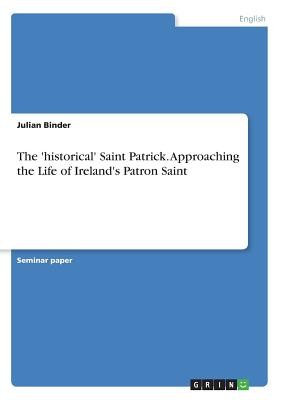
- We will send in 10–14 business days.
- Author: Julian Binder
- Publisher: GRIN Verlag
- ISBN-10: 3668228027
- ISBN-13: 9783668228023
- Format: 14.8 x 21 x 0.3 cm, softcover
- Language: English
- SAVE -10% with code: EXTRA
The 'historical' Saint Patrick. Approaching the Life of Ireland's Patron Saint (e-book) (used book) | bookbook.eu
Reviews
Description
Seminar paper from the year 2015 in the subject English Language and Literature Studies - Culture and Applied Geography, grade: 1.0, University of Tubingen (Department of English), language: English, abstract: When hearing the name 'Saint Patrick', people nowadays think of a bearded, often staffbearing, Irishman who was the first to introduce Christianity to the Emerald Isle, who chased the serpents out of Ireland, and who made use of a shamrock to explain the Holy Trinity. This is the conventional representation of Ireland's National Apostle, and this is what a very high percentage of Saint Patrick's Day visitors would give as an answer if you asked them who Saint Patrick has been. However, this depiction of Ireland´s patron saint is as different from the 'real Patrick' who lived most likely between the end of the fourth and the middle of the fifth century A.D. as is the modern, secular way of celebrating March 17, 'Saint Patrick's Day', with parades, rugby matches, and green beer from its traditional, religious origins, the feast of St. Patrick's 'falling asleep', which had been celebrated as early as the ninth century. Neither was he Irish, nor was he the first to introduce Christianity on the island, nor did he chase any of the poisonous snakes out of Ireland as there simply were none in the country after the most recent Ice Age. So, in fact, the prevailing popular image of Saint Patrick is - at least historically speaking - distorted and inaccurate. What may be the reason for such a misrepresentation of the 'real Patrick'? Allanah Hopkin gets to the core of the problem by stating that "[m]any people still confuse the Saint Patrick of legend with the very different historical figure." In her work The Living Legend of Saint Patrick, she points out the different developmental stages of the representations of Patrick over the centuries. According to her, even Patrick's earliest biographers elevated Patrick´s life to that of a secular hero. In the following lines
EXTRA 10 % discount with code: EXTRA
The promotion ends in 16d.08:10:10
The discount code is valid when purchasing from 10 €. Discounts do not stack.
- Author: Julian Binder
- Publisher: GRIN Verlag
- ISBN-10: 3668228027
- ISBN-13: 9783668228023
- Format: 14.8 x 21 x 0.3 cm, softcover
- Language: English English
Seminar paper from the year 2015 in the subject English Language and Literature Studies - Culture and Applied Geography, grade: 1.0, University of Tubingen (Department of English), language: English, abstract: When hearing the name 'Saint Patrick', people nowadays think of a bearded, often staffbearing, Irishman who was the first to introduce Christianity to the Emerald Isle, who chased the serpents out of Ireland, and who made use of a shamrock to explain the Holy Trinity. This is the conventional representation of Ireland's National Apostle, and this is what a very high percentage of Saint Patrick's Day visitors would give as an answer if you asked them who Saint Patrick has been. However, this depiction of Ireland´s patron saint is as different from the 'real Patrick' who lived most likely between the end of the fourth and the middle of the fifth century A.D. as is the modern, secular way of celebrating March 17, 'Saint Patrick's Day', with parades, rugby matches, and green beer from its traditional, religious origins, the feast of St. Patrick's 'falling asleep', which had been celebrated as early as the ninth century. Neither was he Irish, nor was he the first to introduce Christianity on the island, nor did he chase any of the poisonous snakes out of Ireland as there simply were none in the country after the most recent Ice Age. So, in fact, the prevailing popular image of Saint Patrick is - at least historically speaking - distorted and inaccurate. What may be the reason for such a misrepresentation of the 'real Patrick'? Allanah Hopkin gets to the core of the problem by stating that "[m]any people still confuse the Saint Patrick of legend with the very different historical figure." In her work The Living Legend of Saint Patrick, she points out the different developmental stages of the representations of Patrick over the centuries. According to her, even Patrick's earliest biographers elevated Patrick´s life to that of a secular hero. In the following lines


Reviews